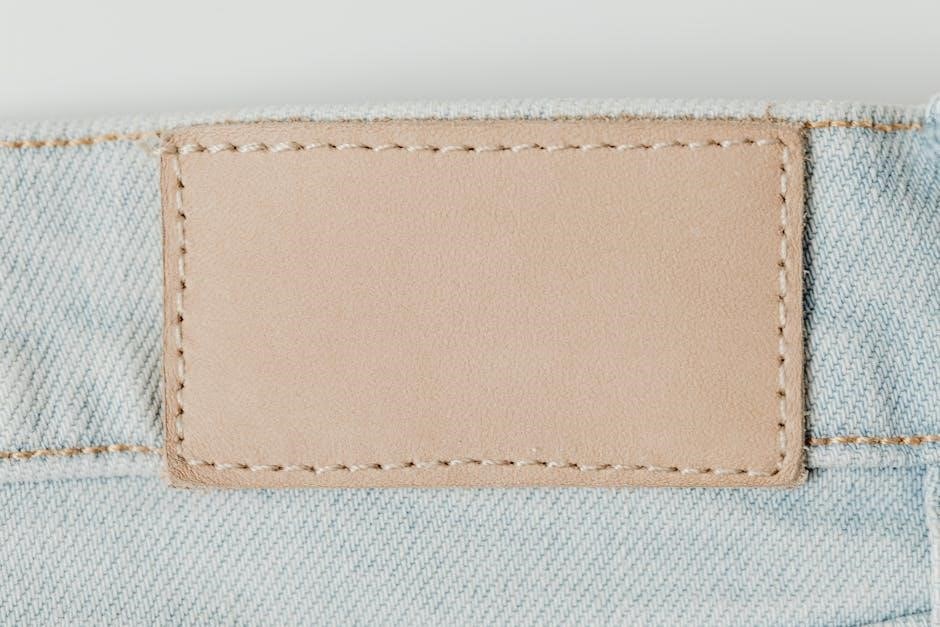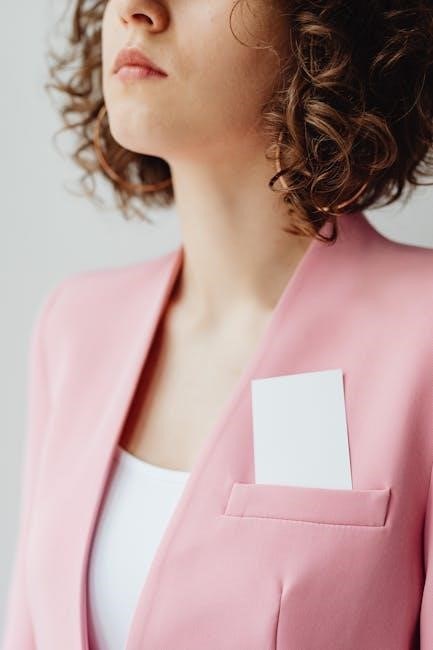welt pocket tutorial
Welcome to our comprehensive welt pocket tutorial! Learn the basics of creating elegant, professional-looking pockets for garments like jackets, trousers, and more. Discover single and double welt techniques, essential tools, and step-by-step construction methods to enhance your sewing skills.
Overview of Welt Pockets
A welt pocket is a sophisticated feature commonly found in tailored garments like suits, jackets, and trousers. It consists of a rectangular opening with one or two flaps, adding both functionality and elegance. The pocket is constructed using a welt piece, which creates a clean, finished edge. Welt pockets can be single or double, with the double welt being more formal, often seen in tuxedos. They are versatile, suitable for various fabrics and styles, and can be customized with zippers or additional details to enhance functionality and aesthetics. This timeless design is a staple in high-end garment construction.
Importance of Welt Pockets in Garment Construction
Welt pockets are a hallmark of quality in tailored garments, offering a professional finish and timeless elegance. They enhance both functionality and aesthetics, providing a clean, polished look. The welt pocket’s construction ensures durability and longevity, making it a staple in high-end clothing. Its sleek design prevents lining or interlining from showing, maintaining a sophisticated appearance. Welt pockets are particularly valued in formal wear, such as suits and tuxedos, where attention to detail is paramount. They reflect craftsmanship and precision, elevating the overall quality of a garment while serving as a practical feature for everyday use.

Tools and Materials Needed
- Fabric for the welt and pocket bag
- Interfacing or fusible stabilizer
- Scissors or rotary cutter
- Sewing machine
- Iron and ironing board
- Zipper (optional)
- Chalk or marking tool
- Seam ripper
Essential Fabric and Notions
To create a welt pocket, you’ll need fabric for the welt and pocket bag, matching your garment’s material. Use a sturdy fabric for the welt to ensure stability. Interfacing or fusible stabilizer is crucial for adding structure and preventing stretching. Optional notions include zippers for a secure closure or decorative elements like flaps. Choose fabrics that complement your garment’s style and durability needs. Proper materials ensure a professional finish and long-lasting wear. Always pre-wash and press fabrics before cutting to avoid shrinkage issues during construction.
Pattern Drafting Tools
Essential tools for drafting a welt pocket pattern include a ruler, measuring tape, or seam gauge for precise measurements. A pencil or marking tool is needed to draw the pattern on fabric. A cutting mat and rotary cutter are optional but helpful for accurate fabric cutting. Use these tools to create a welt piece slightly wider than the pocket opening, ensuring a professional finish. Proper measurement and alignment are crucial for a polished look. These tools help you achieve accurate cuts and symmetrical designs, making the sewing process smoother and the final result more professional.

Pattern Drafting for Welt Pockets
Learn to draft a welt pocket pattern by creating a welt piece slightly wider than the pocket opening. Ensure precise measurements for a professional finish.
Creating the Welt Piece
To create the welt piece, cut a fabric strip slightly wider than the pocket opening. Apply fusible strips to the wrong side for stability. Place the welt on the right side of the garment, aligning the top edge with the marked pocket line. Fold the welt in half, ensuring it evenly covers the opening. Baste the raw edges together on the wrong side. Press the welt to create a crisp crease, forming a professional finish. This step ensures the welt lies flat and prepares it for attaching the pocket bag seamlessly.
Designing the Pocket Bag
The pocket bag is the hidden compartment behind the welt. Cut it slightly larger than the welt opening to ensure ease of use. Use lining fabric for a polished look. Position the pocket bag with the right side down, aligning its top edge with the welt’s bottom. Ensure the sides are evenly spaced and the corners are symmetrical; Pin securely, making sure the bag doesn’t extend beyond the welt. This design creates a sleek, functional compartment that remains invisible from the outside, providing a clean, professional finish to your garment.
Step-by-Step Construction
Master the welt pocket construction through precise cutting, interfacing, and sewing steps. Attach the bag, turn right side out, and press for a polished finish. Elevate your garments with professional-looking pockets.
Cutting and Interfacing
Cut the welt piece 1–2 cm wider than the pocket opening and slightly longer. Use fusible interfacing strips to stabilize the welt edges and pocket opening. Ensure the strips are 2.5 cm wide and align with the pocket’s length. Cut the pocket bag fabric separately, matching the desired size. For a clean finish, interface the pocket bag’s top edge to prevent stretching. Accuracy in cutting is crucial for a professional result. Position all pieces carefully, ensuring proper alignment before moving to sewing. This step sets the foundation for a smooth, polished welt pocket construction.
Sewing the Welt
Begin by basting the raw edges of the welt together on the wrong side of the garment. Fold the welt in half, ensuring it evenly covers the pocket opening. Sew along the folded edge from the right side, using a matching thread color. This step secures the welt in place and creates a clean finish. Press the welt to create a sharp crease, ensuring it lies flat and even. Avoid sewing too tightly, as this could pucker the fabric. Proper alignment and even stitching are key for a professional-looking welt pocket. This step sets the stage for attaching the pocket bag seamlessly.
Attaching the Pocket Bag
Place the pocket bag with the right side down on top of the welt, aligning the raw edges. Ensure the pocket bag is centered and evenly positioned. Sew along the edges of the pocket bag, leaving a small opening for turning. Carefully trim excess fabric and turn the pocket bag right side out. Press the seams to create a crisp fold. Slip-stitch or sew the opening shut by hand or machine. Ensure the pocket bag lies smoothly behind the welt, creating a clean and professional finish. This step completes the integration of the pocket bag with the welt, ready for use.
Turning the Pocket Right Side Out
Carefully turn the pocket right side out through the small opening. Use a blunt tool like a chopstick or pencil to push out the corners gently. Ensure the seams are fully extended and the edges are smooth. Press the pocket with an iron to create a crisp fold, making sure the seams lie flat. This step is crucial for achieving a professional finish. Avoid pulling the fabric excessively to prevent distortion. Once turned and pressed, the pocket should appear clean and neatly constructed, ready for final attachment to the garment.
Pressing the Pocket
Pressing is crucial for a professional finish. Use steam to flatten seams and shape the pocket. Iron the welt edges crisp, ensuring a smooth, even surface for a polished look.
Techniques for a Professional Finish
Achieving a polished look involves precise pressing and shaping. Steam-press the welt to flatten seams and create sharp edges. Topstitching enhances durability and adds a refined aesthetic. Fold the pocket bag neatly, ensuring it lies flat. Use a tailor’s ham to press curved areas smoothly. Pay attention to the welt’s alignment, ensuring it sits evenly. These techniques ensure a crisp, professional finish, elevating your garment’s quality and appearance. Proper pressing and shaping are essential for a welt pocket that looks tailored and well-crafted.

Variations of Welt Pockets
Explore single and double welt pockets, each offering unique styles. Single welts are sleek, while double welts add formality. Zippers and flaps can enhance functionality and aesthetics.
Single vs. Double Welt Pockets
A single welt pocket features one lip meeting the bonded edge, offering a sleek, minimalist look. Double welt pockets, more formal, have two visible lips for a polished appearance. Single welts are ideal for casual garments, while double welts suit tailored suits and tuxedos. Both constructions start similarly but differ in the number of welts and finishing steps. Double welts add sophistication but require precise alignment. Choose based on desired formality and garment type, ensuring a professional finish for either style.
Adding a Zipper to the Welt Pocket
Adding a zipper to a welt pocket enhances functionality and security. Begin by creating the pocket opening as usual, then attach the zipper to the welt piece. Position the zipper so it aligns with the pocket edges, ensuring it lies flat. Sew the zipper in place, folding the welt to cover the zipper teeth. Topstitch for reinforcement and a polished look. This method works for both single and double welt pockets, offering a sleek, secure closure. It’s ideal for bags, jackets, or any garment requiring a discrete yet functional pocket solution.
Beginner Tips and Tricks
Start with the right fabric and tools. Use fusible interfacing for stability and mark carefully. Press as you go for crisp results. Practice on scrap fabric before sewing your final garment to ensure accuracy and confidence.
Common Mistakes to Avoid
When sewing welt pockets, avoid inaccurate marking of the pocket opening, as it can lead to uneven stitching. Ensure the welt fabric is cut correctly, matching the pocket length. Uneven pressing or insufficient interfacing can cause the welt to pucker or misalign. Avoid rushing the process—take time to baste and align edges properly. Using the wrong fabric weight can compromise the pocket’s structure. Additionally, not folding the welt evenly or sewing too loosely can result in a sloppy finish. Practice on scrap fabric to master the technique before working on your final garment.

Advanced Welt Pocket Techniques
Elevate your skills by incorporating flaps, zippers, or contrasting fabrics for a polished look. Explore intricate stitching and creative detailing to add sophistication to your welt pockets.
Incorporating Flaps or Other Details
Incorporate flaps or other details to enhance functionality and style. A flap adds a decorative touch while protecting the pocket opening. Use contrasting fabrics or stitching for a custom look. Attach the flap after sewing the welt, ensuring it lies flat and aligns with the pocket edges. Topstitching reinforces the flap and creates a polished finish. For a more formal look, add a zipper to the welt pocket, following similar steps to the basic welt construction. Experiment with rounded or angled flaps for varied aesthetics. Ensure the flap is securely attached to maintain durability and professionalism in your garment.
Mastering the welt pocket technique elevates your sewing projects, adding professionalism and functionality. Whether for jackets, trousers, or accessories, welt pockets offer a sleek, timeless design. By following this tutorial, you’ve learned to create single and double welt pockets, incorporate flaps, and add zippers for versatility. Practice makes perfect, so experiment with different fabrics and variations to refine your skills. With these techniques, you’ll confidently create elegant, durable pockets that enhance any garment. Happy sewing, and enjoy the satisfaction of crafting beautiful, functional details!
